Functional Analysis and Allocation: A Systems Engineering Report
VerifiedAdded on 2022/11/13
|15
|3279
|461
Report
AI Summary
This report delves into the critical processes of functional analysis and allocation (FA&A) within systems engineering. It begins by defining FA&A as a core process in system design, outlining its inputs and outputs, and situating it within the system lifecycle. The report then describes the methods for performing both analysis and allocation, including functional partitioning, requirements loops, and the development of a functional architecture. It highlights the use of Functional Flow Block Diagrams (FFBDs) and other documentation to illustrate functional characteristics. Furthermore, the report examines requirement allocation, emphasizing the importance of traceability and the allocation of requirements to hardware, software, and other system components. The conclusion emphasizes the importance of FA&A in providing the necessary detail for integrated system design and ensuring all top-level requirements are met through the design process. The paper also highlights the importance of iterative design and the use of software tools for managing complexity.
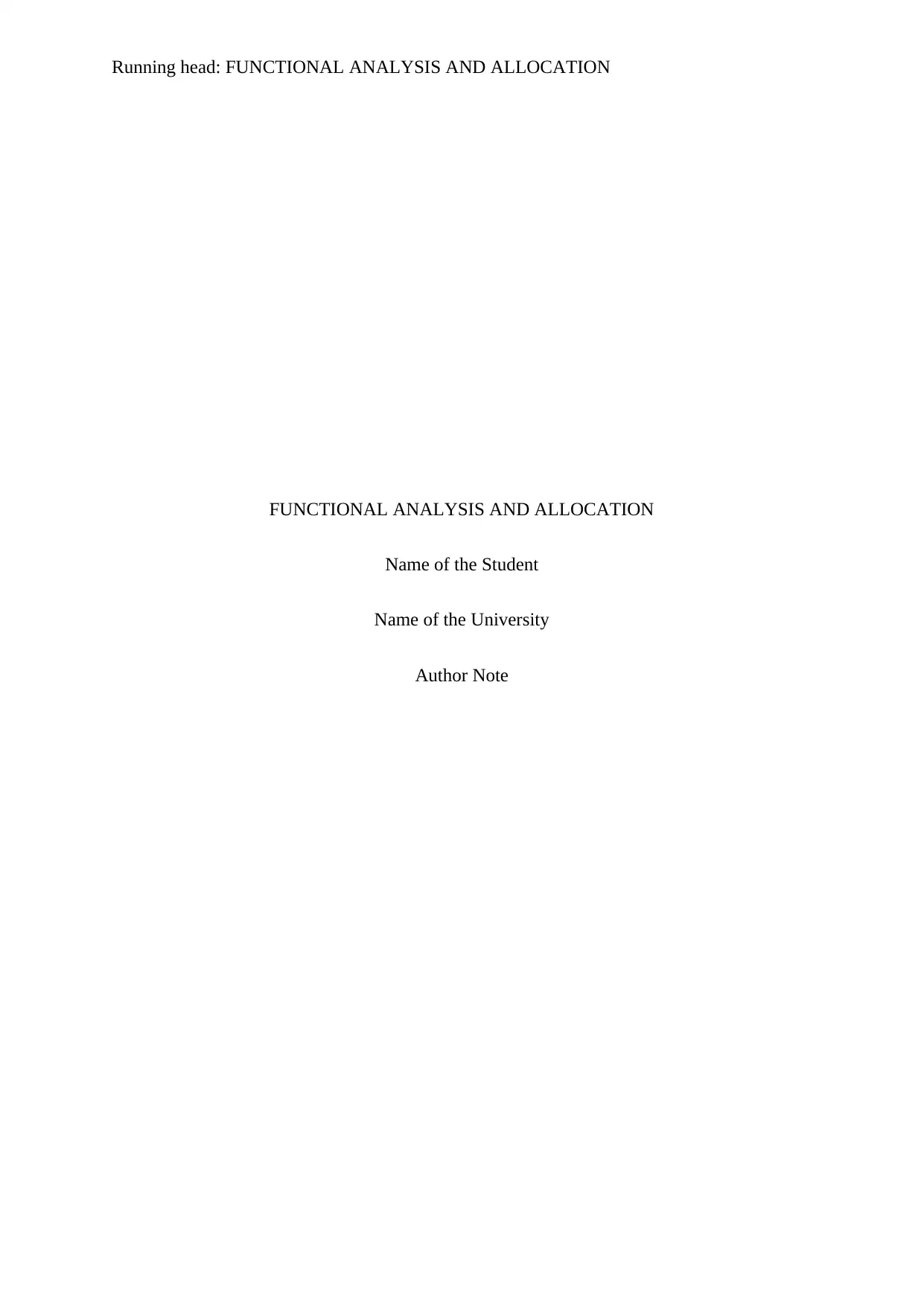
Running head: FUNCTIONAL ANALYSIS AND ALLOCATION
FUNCTIONAL ANALYSIS AND ALLOCATION
Name of the Student
Name of the University
Author Note
FUNCTIONAL ANALYSIS AND ALLOCATION
Name of the Student
Name of the University
Author Note
Paraphrase This Document
Need a fresh take? Get an instant paraphrase of this document with our AI Paraphraser
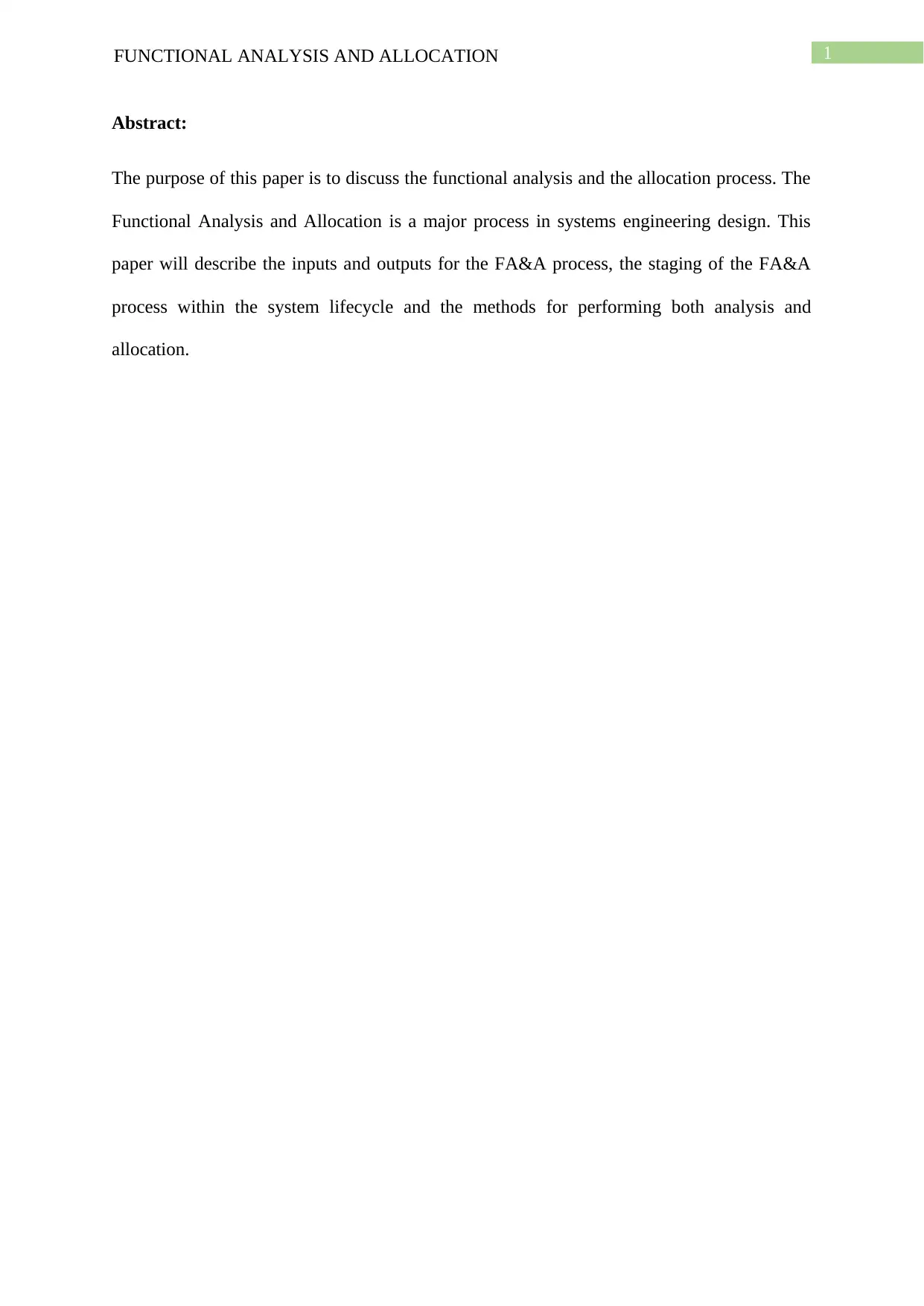
FUNCTIONAL ANALYSIS AND ALLOCATION 1
Abstract:
The purpose of this paper is to discuss the functional analysis and the allocation process. The
Functional Analysis and Allocation is a major process in systems engineering design. This
paper will describe the inputs and outputs for the FA&A process, the staging of the FA&A
process within the system lifecycle and the methods for performing both analysis and
allocation.
Abstract:
The purpose of this paper is to discuss the functional analysis and the allocation process. The
Functional Analysis and Allocation is a major process in systems engineering design. This
paper will describe the inputs and outputs for the FA&A process, the staging of the FA&A
process within the system lifecycle and the methods for performing both analysis and
allocation.
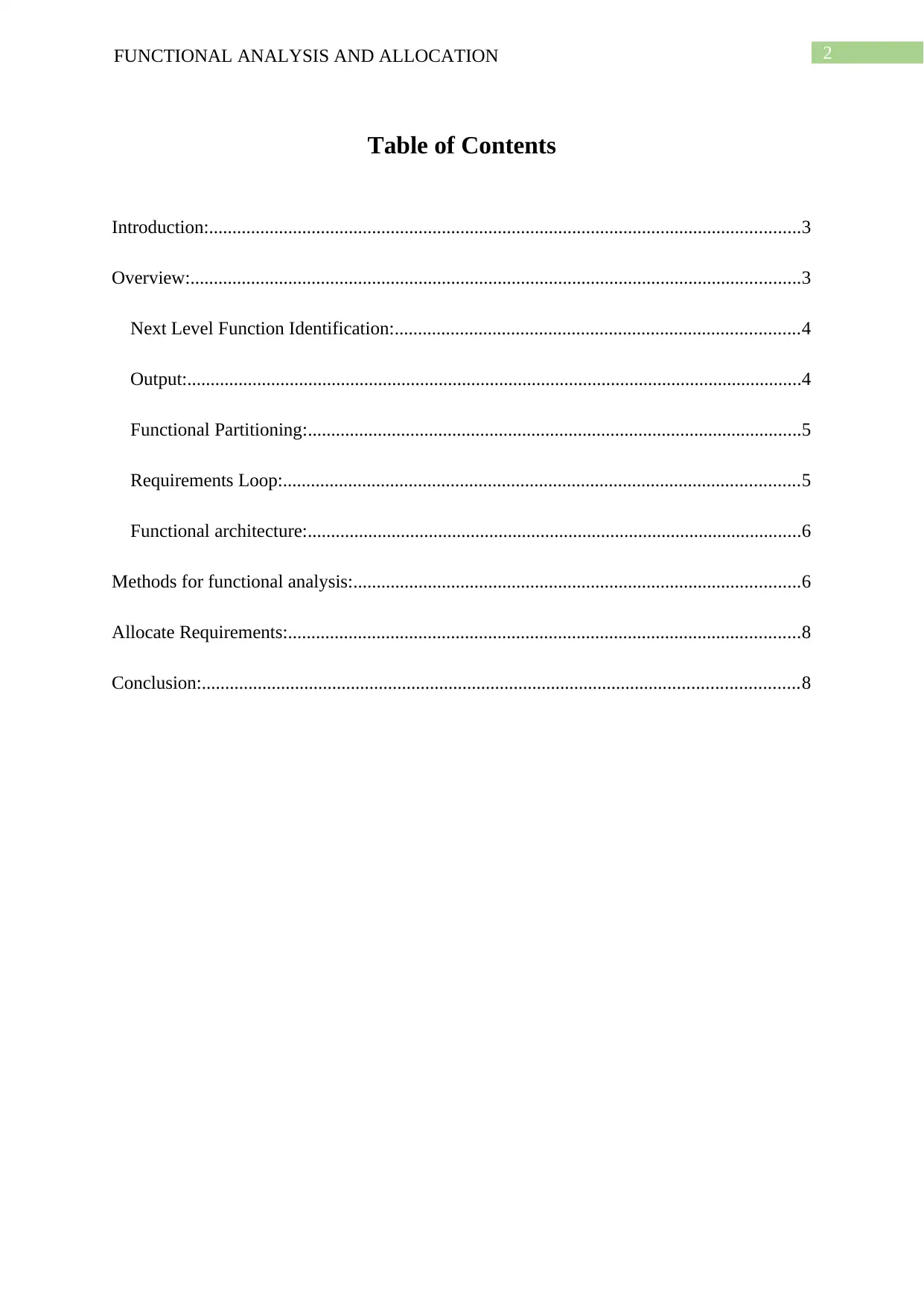
2FUNCTIONAL ANALYSIS AND ALLOCATION
Table of Contents
Introduction:...............................................................................................................................3
Overview:...................................................................................................................................3
Next Level Function Identification:.......................................................................................4
Output:....................................................................................................................................4
Functional Partitioning:..........................................................................................................5
Requirements Loop:...............................................................................................................5
Functional architecture:..........................................................................................................6
Methods for functional analysis:................................................................................................6
Allocate Requirements:..............................................................................................................8
Conclusion:................................................................................................................................8
Table of Contents
Introduction:...............................................................................................................................3
Overview:...................................................................................................................................3
Next Level Function Identification:.......................................................................................4
Output:....................................................................................................................................4
Functional Partitioning:..........................................................................................................5
Requirements Loop:...............................................................................................................5
Functional architecture:..........................................................................................................6
Methods for functional analysis:................................................................................................6
Allocate Requirements:..............................................................................................................8
Conclusion:................................................................................................................................8
⊘ This is a preview!⊘
Do you want full access?
Subscribe today to unlock all pages.

Trusted by 1+ million students worldwide
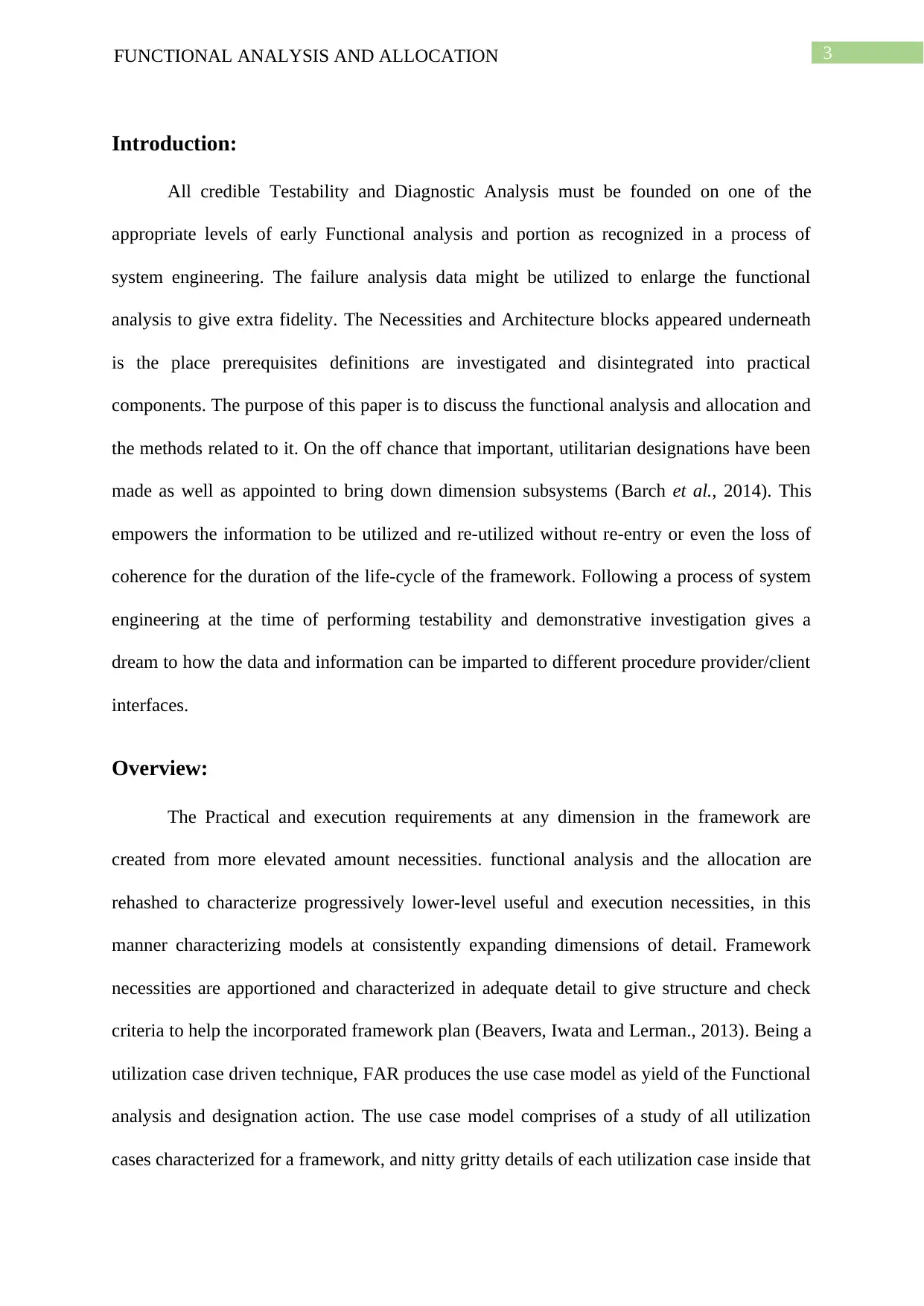
3FUNCTIONAL ANALYSIS AND ALLOCATION
Introduction:
All credible Testability and Diagnostic Analysis must be founded on one of the
appropriate levels of early Functional analysis and portion as recognized in a process of
system engineering. The failure analysis data might be utilized to enlarge the functional
analysis to give extra fidelity. The Necessities and Architecture blocks appeared underneath
is the place prerequisites definitions are investigated and disintegrated into practical
components. The purpose of this paper is to discuss the functional analysis and allocation and
the methods related to it. On the off chance that important, utilitarian designations have been
made as well as appointed to bring down dimension subsystems (Barch et al., 2014). This
empowers the information to be utilized and re-utilized without re-entry or even the loss of
coherence for the duration of the life-cycle of the framework. Following a process of system
engineering at the time of performing testability and demonstrative investigation gives a
dream to how the data and information can be imparted to different procedure provider/client
interfaces.
Overview:
The Practical and execution requirements at any dimension in the framework are
created from more elevated amount necessities. functional analysis and the allocation are
rehashed to characterize progressively lower-level useful and execution necessities, in this
manner characterizing models at consistently expanding dimensions of detail. Framework
necessities are apportioned and characterized in adequate detail to give structure and check
criteria to help the incorporated framework plan (Beavers, Iwata and Lerman., 2013). Being a
utilization case driven technique, FAR produces the use case model as yield of the Functional
analysis and designation action. The use case model comprises of a study of all utilization
cases characterized for a framework, and nitty gritty details of each utilization case inside that
Introduction:
All credible Testability and Diagnostic Analysis must be founded on one of the
appropriate levels of early Functional analysis and portion as recognized in a process of
system engineering. The failure analysis data might be utilized to enlarge the functional
analysis to give extra fidelity. The Necessities and Architecture blocks appeared underneath
is the place prerequisites definitions are investigated and disintegrated into practical
components. The purpose of this paper is to discuss the functional analysis and allocation and
the methods related to it. On the off chance that important, utilitarian designations have been
made as well as appointed to bring down dimension subsystems (Barch et al., 2014). This
empowers the information to be utilized and re-utilized without re-entry or even the loss of
coherence for the duration of the life-cycle of the framework. Following a process of system
engineering at the time of performing testability and demonstrative investigation gives a
dream to how the data and information can be imparted to different procedure provider/client
interfaces.
Overview:
The Practical and execution requirements at any dimension in the framework are
created from more elevated amount necessities. functional analysis and the allocation are
rehashed to characterize progressively lower-level useful and execution necessities, in this
manner characterizing models at consistently expanding dimensions of detail. Framework
necessities are apportioned and characterized in adequate detail to give structure and check
criteria to help the incorporated framework plan (Beavers, Iwata and Lerman., 2013). Being a
utilization case driven technique, FAR produces the use case model as yield of the Functional
analysis and designation action. The use case model comprises of a study of all utilization
cases characterized for a framework, and nitty gritty details of each utilization case inside that
Paraphrase This Document
Need a fresh take? Get an instant paraphrase of this document with our AI Paraphraser
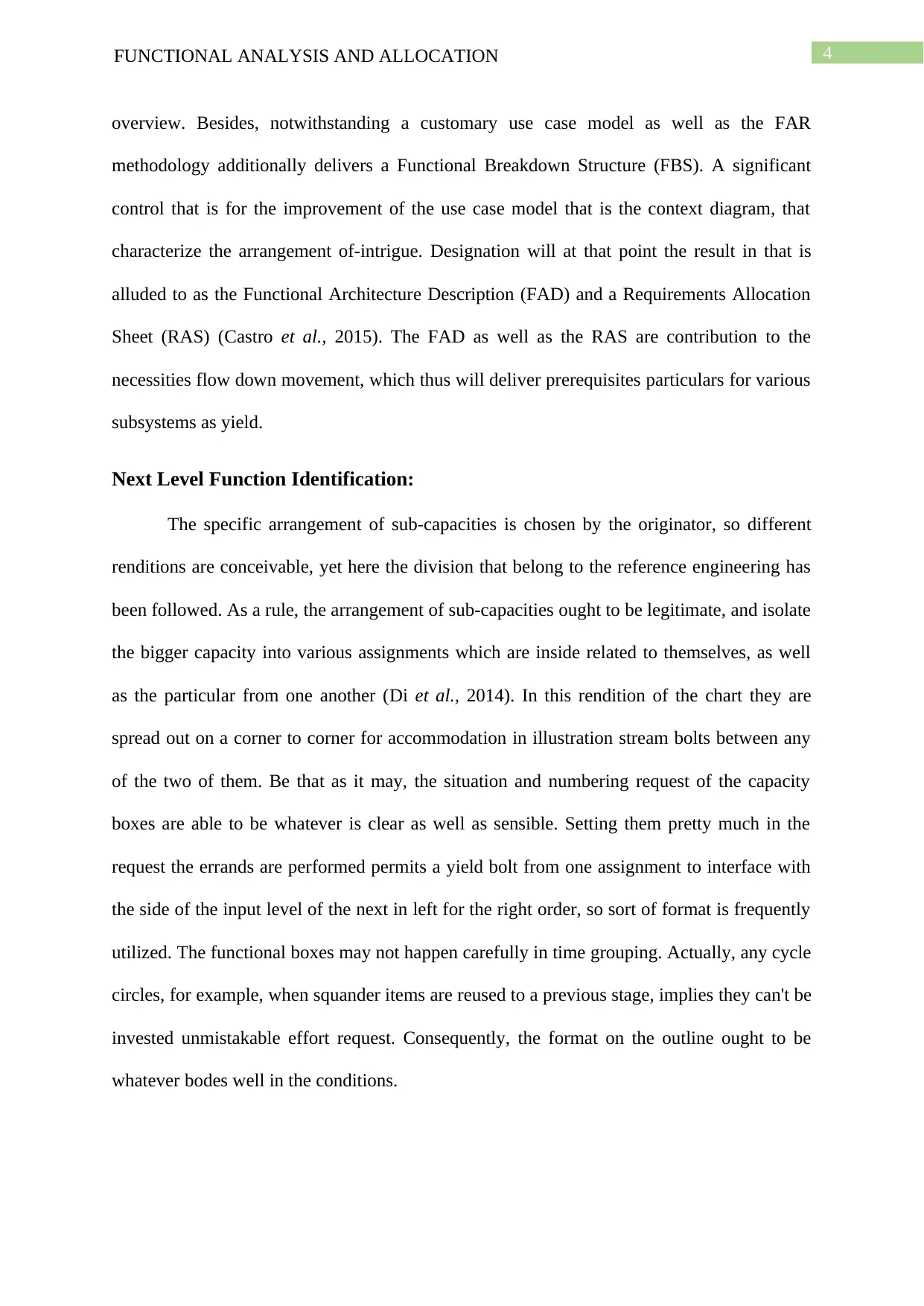
4FUNCTIONAL ANALYSIS AND ALLOCATION
overview. Besides, notwithstanding a customary use case model as well as the FAR
methodology additionally delivers a Functional Breakdown Structure (FBS). A significant
control that is for the improvement of the use case model that is the context diagram, that
characterize the arrangement of-intrigue. Designation will at that point the result in that is
alluded to as the Functional Architecture Description (FAD) and a Requirements Allocation
Sheet (RAS) (Castro et al., 2015). The FAD as well as the RAS are contribution to the
necessities flow down movement, which thus will deliver prerequisites particulars for various
subsystems as yield.
Next Level Function Identification:
The specific arrangement of sub-capacities is chosen by the originator, so different
renditions are conceivable, yet here the division that belong to the reference engineering has
been followed. As a rule, the arrangement of sub-capacities ought to be legitimate, and isolate
the bigger capacity into various assignments which are inside related to themselves, as well
as the particular from one another (Di et al., 2014). In this rendition of the chart they are
spread out on a corner to corner for accommodation in illustration stream bolts between any
of the two of them. Be that as it may, the situation and numbering request of the capacity
boxes are able to be whatever is clear as well as sensible. Setting them pretty much in the
request the errands are performed permits a yield bolt from one assignment to interface with
the side of the input level of the next in left for the right order, so sort of format is frequently
utilized. The functional boxes may not happen carefully in time grouping. Actually, any cycle
circles, for example, when squander items are reused to a previous stage, implies they can't be
invested unmistakable effort request. Consequently, the format on the outline ought to be
whatever bodes well in the conditions.
overview. Besides, notwithstanding a customary use case model as well as the FAR
methodology additionally delivers a Functional Breakdown Structure (FBS). A significant
control that is for the improvement of the use case model that is the context diagram, that
characterize the arrangement of-intrigue. Designation will at that point the result in that is
alluded to as the Functional Architecture Description (FAD) and a Requirements Allocation
Sheet (RAS) (Castro et al., 2015). The FAD as well as the RAS are contribution to the
necessities flow down movement, which thus will deliver prerequisites particulars for various
subsystems as yield.
Next Level Function Identification:
The specific arrangement of sub-capacities is chosen by the originator, so different
renditions are conceivable, yet here the division that belong to the reference engineering has
been followed. As a rule, the arrangement of sub-capacities ought to be legitimate, and isolate
the bigger capacity into various assignments which are inside related to themselves, as well
as the particular from one another (Di et al., 2014). In this rendition of the chart they are
spread out on a corner to corner for accommodation in illustration stream bolts between any
of the two of them. Be that as it may, the situation and numbering request of the capacity
boxes are able to be whatever is clear as well as sensible. Setting them pretty much in the
request the errands are performed permits a yield bolt from one assignment to interface with
the side of the input level of the next in left for the right order, so sort of format is frequently
utilized. The functional boxes may not happen carefully in time grouping. Actually, any cycle
circles, for example, when squander items are reused to a previous stage, implies they can't be
invested unmistakable effort request. Consequently, the format on the outline ought to be
whatever bodes well in the conditions.
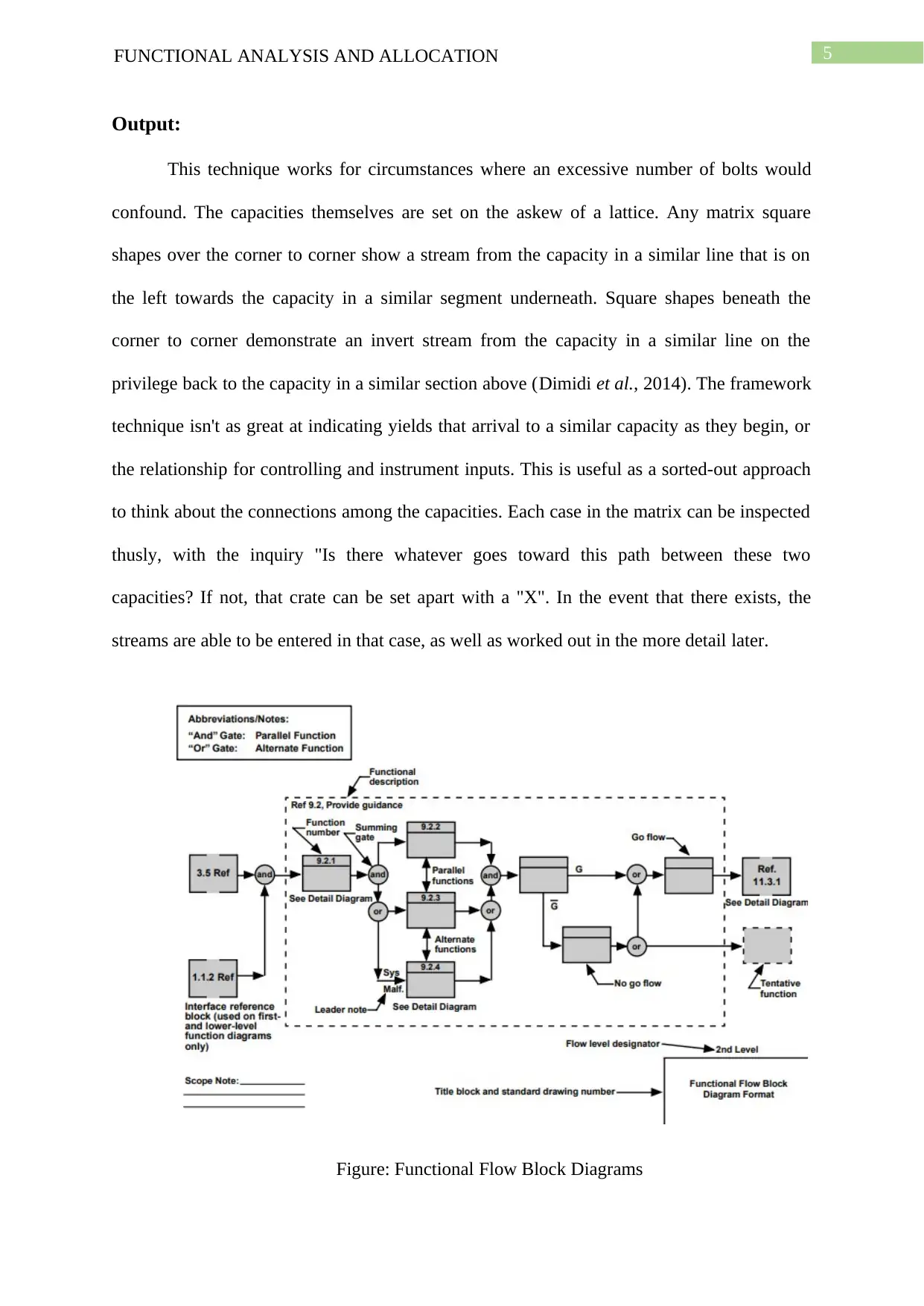
5FUNCTIONAL ANALYSIS AND ALLOCATION
Output:
This technique works for circumstances where an excessive number of bolts would
confound. The capacities themselves are set on the askew of a lattice. Any matrix square
shapes over the corner to corner show a stream from the capacity in a similar line that is on
the left towards the capacity in a similar segment underneath. Square shapes beneath the
corner to corner demonstrate an invert stream from the capacity in a similar line on the
privilege back to the capacity in a similar section above (Dimidi et al., 2014). The framework
technique isn't as great at indicating yields that arrival to a similar capacity as they begin, or
the relationship for controlling and instrument inputs. This is useful as a sorted-out approach
to think about the connections among the capacities. Each case in the matrix can be inspected
thusly, with the inquiry "Is there whatever goes toward this path between these two
capacities? If not, that crate can be set apart with a "X". In the event that there exists, the
streams are able to be entered in that case, as well as worked out in the more detail later.
Figure: Functional Flow Block Diagrams
Output:
This technique works for circumstances where an excessive number of bolts would
confound. The capacities themselves are set on the askew of a lattice. Any matrix square
shapes over the corner to corner show a stream from the capacity in a similar line that is on
the left towards the capacity in a similar segment underneath. Square shapes beneath the
corner to corner demonstrate an invert stream from the capacity in a similar line on the
privilege back to the capacity in a similar section above (Dimidi et al., 2014). The framework
technique isn't as great at indicating yields that arrival to a similar capacity as they begin, or
the relationship for controlling and instrument inputs. This is useful as a sorted-out approach
to think about the connections among the capacities. Each case in the matrix can be inspected
thusly, with the inquiry "Is there whatever goes toward this path between these two
capacities? If not, that crate can be set apart with a "X". In the event that there exists, the
streams are able to be entered in that case, as well as worked out in the more detail later.
Figure: Functional Flow Block Diagrams
⊘ This is a preview!⊘
Do you want full access?
Subscribe today to unlock all pages.

Trusted by 1+ million students worldwide
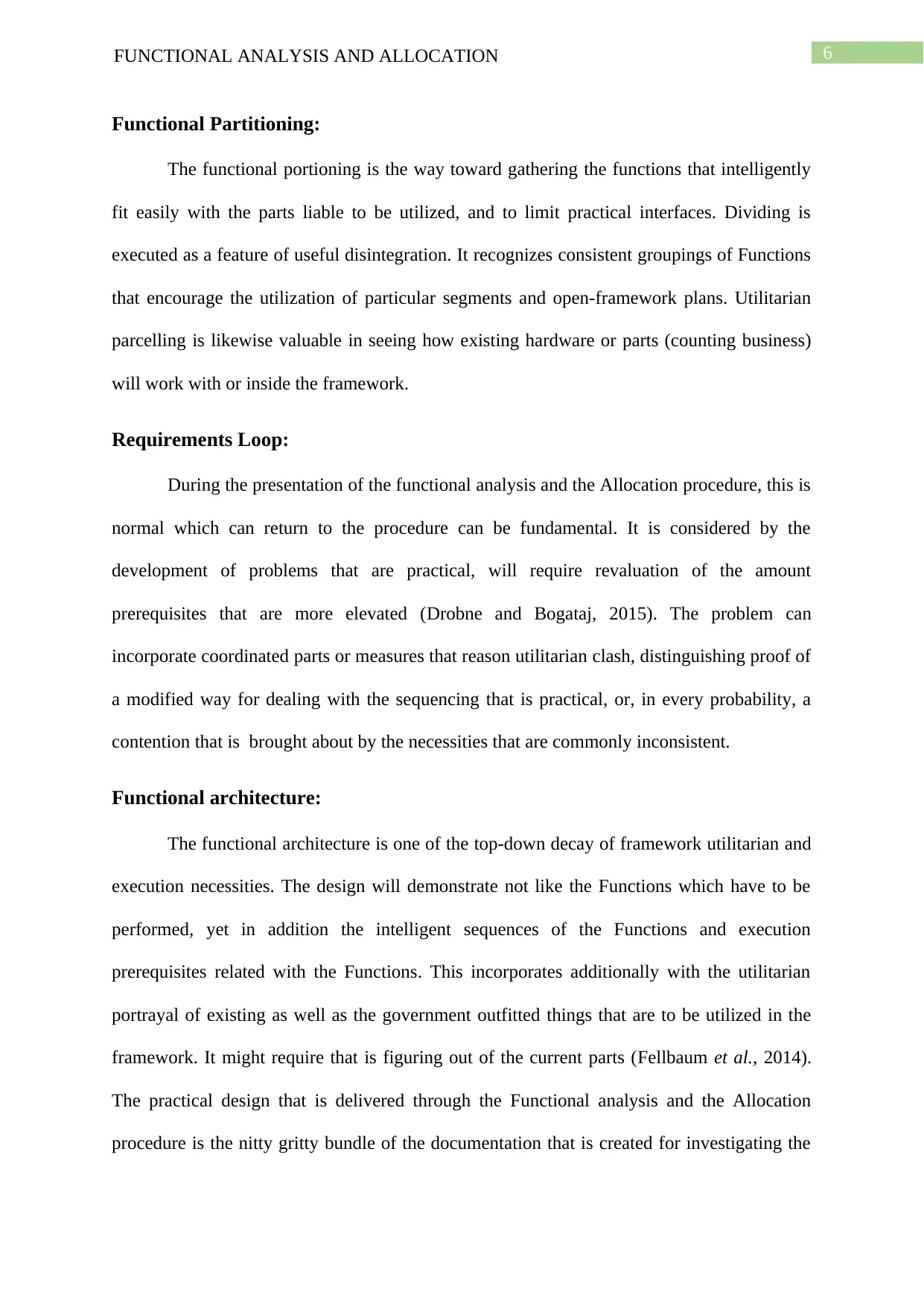
6FUNCTIONAL ANALYSIS AND ALLOCATION
Functional Partitioning:
The functional portioning is the way toward gathering the functions that intelligently
fit easily with the parts liable to be utilized, and to limit practical interfaces. Dividing is
executed as a feature of useful disintegration. It recognizes consistent groupings of Functions
that encourage the utilization of particular segments and open-framework plans. Utilitarian
parcelling is likewise valuable in seeing how existing hardware or parts (counting business)
will work with or inside the framework.
Requirements Loop:
During the presentation of the functional analysis and the Allocation procedure, this is
normal which can return to the procedure can be fundamental. It is considered by the
development of problems that are practical, will require revaluation of the amount
prerequisites that are more elevated (Drobne and Bogataj, 2015). The problem can
incorporate coordinated parts or measures that reason utilitarian clash, distinguishing proof of
a modified way for dealing with the sequencing that is practical, or, in every probability, a
contention that is brought about by the necessities that are commonly inconsistent.
Functional architecture:
The functional architecture is one of the top-down decay of framework utilitarian and
execution necessities. The design will demonstrate not like the Functions which have to be
performed, yet in addition the intelligent sequences of the Functions and execution
prerequisites related with the Functions. This incorporates additionally with the utilitarian
portrayal of existing as well as the government outfitted things that are to be utilized in the
framework. It might require that is figuring out of the current parts (Fellbaum et al., 2014).
The practical design that is delivered through the Functional analysis and the Allocation
procedure is the nitty gritty bundle of the documentation that is created for investigating the
Functional Partitioning:
The functional portioning is the way toward gathering the functions that intelligently
fit easily with the parts liable to be utilized, and to limit practical interfaces. Dividing is
executed as a feature of useful disintegration. It recognizes consistent groupings of Functions
that encourage the utilization of particular segments and open-framework plans. Utilitarian
parcelling is likewise valuable in seeing how existing hardware or parts (counting business)
will work with or inside the framework.
Requirements Loop:
During the presentation of the functional analysis and the Allocation procedure, this is
normal which can return to the procedure can be fundamental. It is considered by the
development of problems that are practical, will require revaluation of the amount
prerequisites that are more elevated (Drobne and Bogataj, 2015). The problem can
incorporate coordinated parts or measures that reason utilitarian clash, distinguishing proof of
a modified way for dealing with the sequencing that is practical, or, in every probability, a
contention that is brought about by the necessities that are commonly inconsistent.
Functional architecture:
The functional architecture is one of the top-down decay of framework utilitarian and
execution necessities. The design will demonstrate not like the Functions which have to be
performed, yet in addition the intelligent sequences of the Functions and execution
prerequisites related with the Functions. This incorporates additionally with the utilitarian
portrayal of existing as well as the government outfitted things that are to be utilized in the
framework. It might require that is figuring out of the current parts (Fellbaum et al., 2014).
The practical design that is delivered through the Functional analysis and the Allocation
procedure is the nitty gritty bundle of the documentation that is created for investigating the
Paraphrase This Document
Need a fresh take? Get an instant paraphrase of this document with our AI Paraphraser
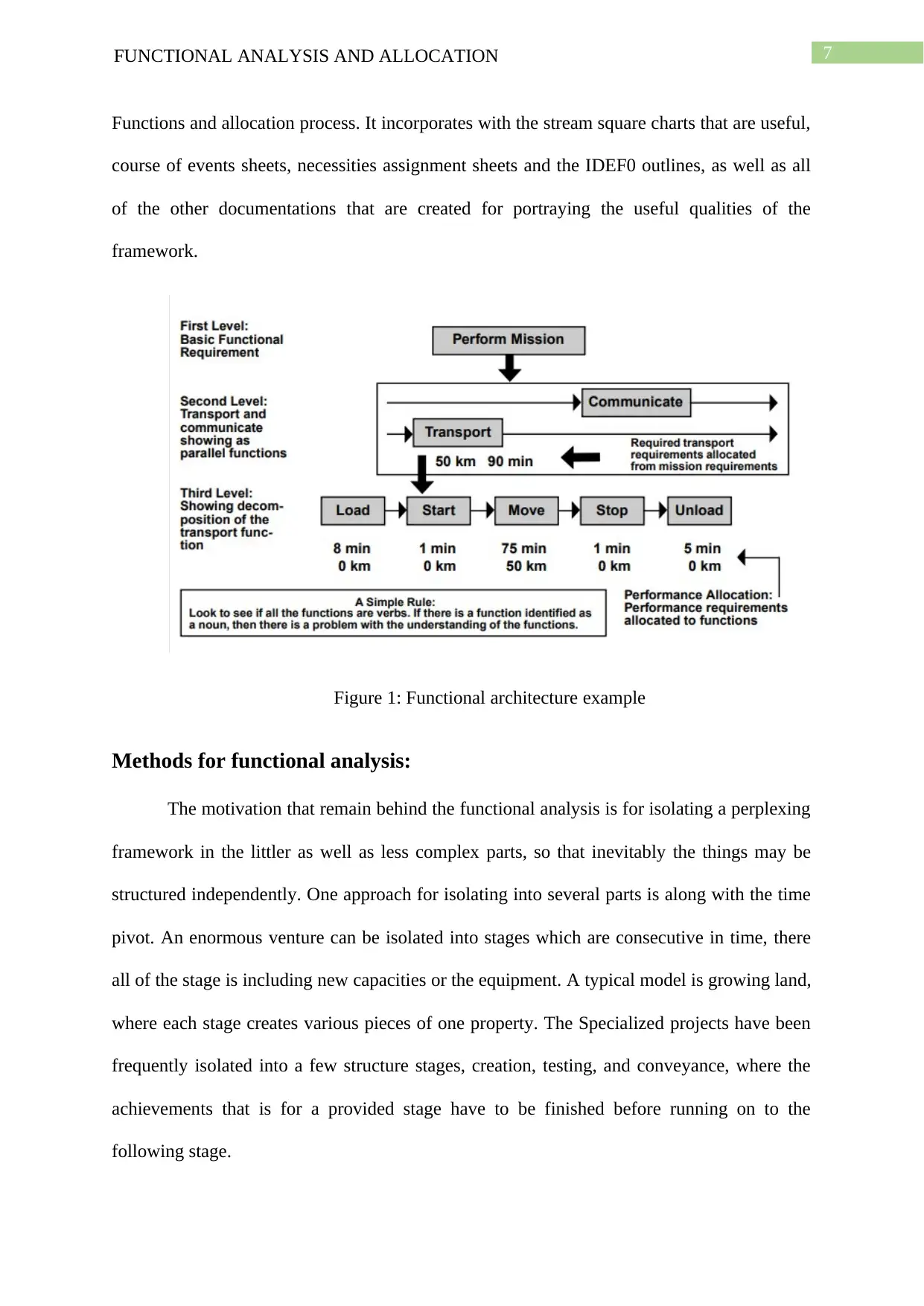
7FUNCTIONAL ANALYSIS AND ALLOCATION
Functions and allocation process. It incorporates with the stream square charts that are useful,
course of events sheets, necessities assignment sheets and the IDEF0 outlines, as well as all
of the other documentations that are created for portraying the useful qualities of the
framework.
Figure 1: Functional architecture example
Methods for functional analysis:
The motivation that remain behind the functional analysis is for isolating a perplexing
framework in the littler as well as less complex parts, so that inevitably the things may be
structured independently. One approach for isolating into several parts is along with the time
pivot. An enormous venture can be isolated into stages which are consecutive in time, there
all of the stage is including new capacities or the equipment. A typical model is growing land,
where each stage creates various pieces of one property. The Specialized projects have been
frequently isolated into a few structure stages, creation, testing, and conveyance, where the
achievements that is for a provided stage have to be finished before running on to the
following stage.
Functions and allocation process. It incorporates with the stream square charts that are useful,
course of events sheets, necessities assignment sheets and the IDEF0 outlines, as well as all
of the other documentations that are created for portraying the useful qualities of the
framework.
Figure 1: Functional architecture example
Methods for functional analysis:
The motivation that remain behind the functional analysis is for isolating a perplexing
framework in the littler as well as less complex parts, so that inevitably the things may be
structured independently. One approach for isolating into several parts is along with the time
pivot. An enormous venture can be isolated into stages which are consecutive in time, there
all of the stage is including new capacities or the equipment. A typical model is growing land,
where each stage creates various pieces of one property. The Specialized projects have been
frequently isolated into a few structure stages, creation, testing, and conveyance, where the
achievements that is for a provided stage have to be finished before running on to the
following stage.
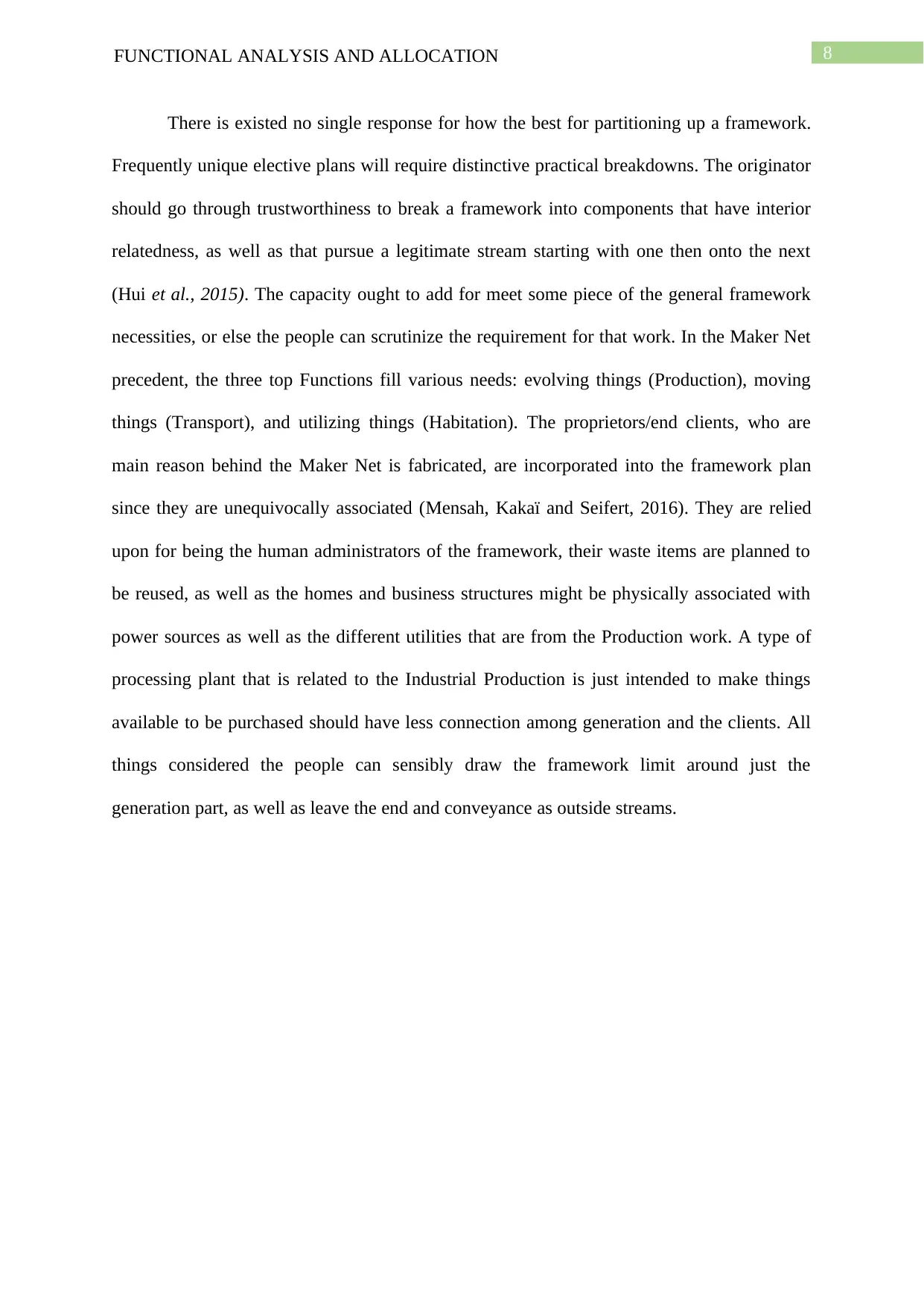
8FUNCTIONAL ANALYSIS AND ALLOCATION
There is existed no single response for how the best for partitioning up a framework.
Frequently unique elective plans will require distinctive practical breakdowns. The originator
should go through trustworthiness to break a framework into components that have interior
relatedness, as well as that pursue a legitimate stream starting with one then onto the next
(Hui et al., 2015). The capacity ought to add for meet some piece of the general framework
necessities, or else the people can scrutinize the requirement for that work. In the Maker Net
precedent, the three top Functions fill various needs: evolving things (Production), moving
things (Transport), and utilizing things (Habitation). The proprietors/end clients, who are
main reason behind the Maker Net is fabricated, are incorporated into the framework plan
since they are unequivocally associated (Mensah, Kakaï and Seifert, 2016). They are relied
upon for being the human administrators of the framework, their waste items are planned to
be reused, as well as the homes and business structures might be physically associated with
power sources as well as the different utilities that are from the Production work. A type of
processing plant that is related to the Industrial Production is just intended to make things
available to be purchased should have less connection among generation and the clients. All
things considered the people can sensibly draw the framework limit around just the
generation part, as well as leave the end and conveyance as outside streams.
There is existed no single response for how the best for partitioning up a framework.
Frequently unique elective plans will require distinctive practical breakdowns. The originator
should go through trustworthiness to break a framework into components that have interior
relatedness, as well as that pursue a legitimate stream starting with one then onto the next
(Hui et al., 2015). The capacity ought to add for meet some piece of the general framework
necessities, or else the people can scrutinize the requirement for that work. In the Maker Net
precedent, the three top Functions fill various needs: evolving things (Production), moving
things (Transport), and utilizing things (Habitation). The proprietors/end clients, who are
main reason behind the Maker Net is fabricated, are incorporated into the framework plan
since they are unequivocally associated (Mensah, Kakaï and Seifert, 2016). They are relied
upon for being the human administrators of the framework, their waste items are planned to
be reused, as well as the homes and business structures might be physically associated with
power sources as well as the different utilities that are from the Production work. A type of
processing plant that is related to the Industrial Production is just intended to make things
available to be purchased should have less connection among generation and the clients. All
things considered the people can sensibly draw the framework limit around just the
generation part, as well as leave the end and conveyance as outside streams.
⊘ This is a preview!⊘
Do you want full access?
Subscribe today to unlock all pages.

Trusted by 1+ million students worldwide
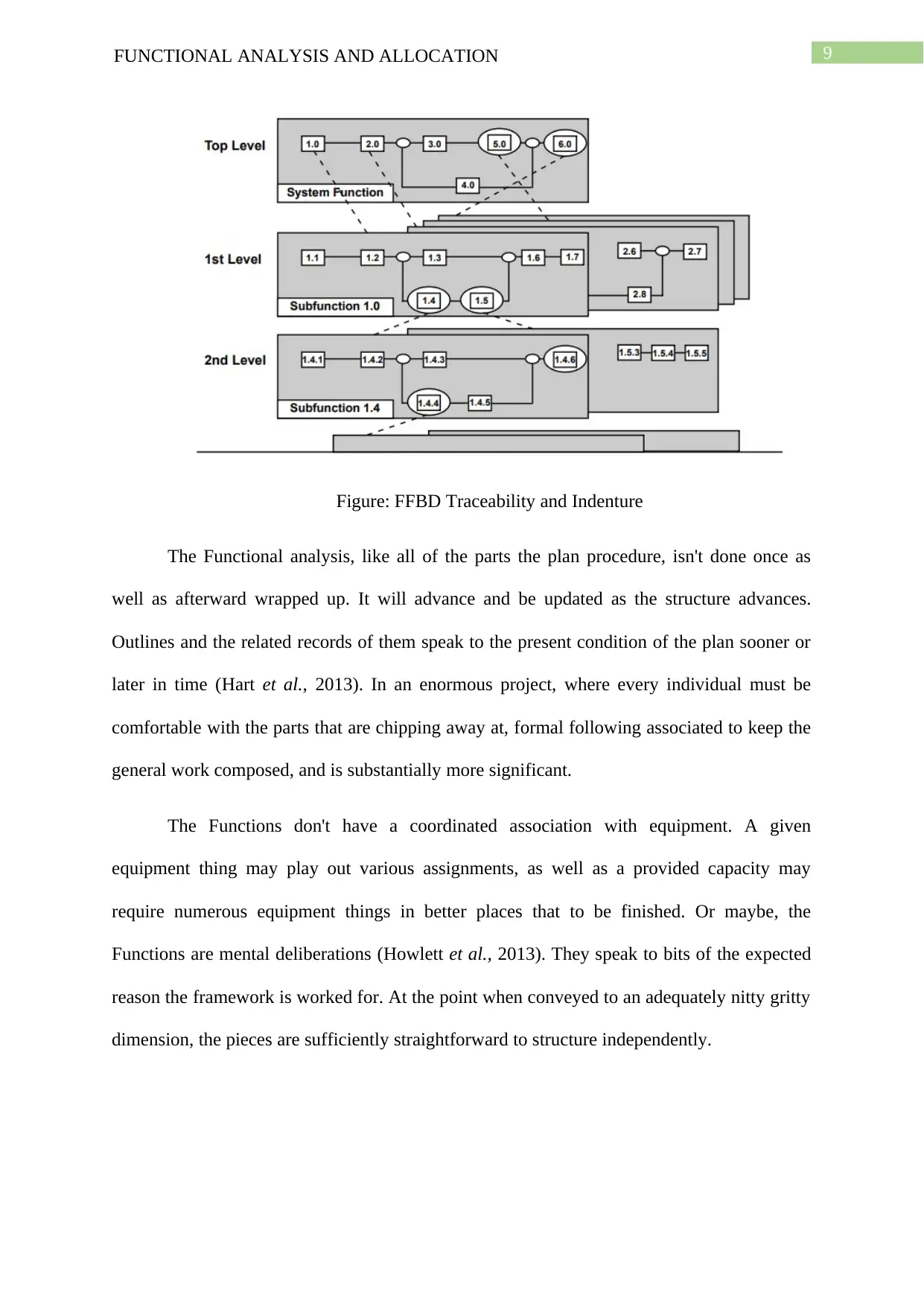
9FUNCTIONAL ANALYSIS AND ALLOCATION
Figure: FFBD Traceability and Indenture
The Functional analysis, like all of the parts the plan procedure, isn't done once as
well as afterward wrapped up. It will advance and be updated as the structure advances.
Outlines and the related records of them speak to the present condition of the plan sooner or
later in time (Hart et al., 2013). In an enormous project, where every individual must be
comfortable with the parts that are chipping away at, formal following associated to keep the
general work composed, and is substantially more significant.
The Functions don't have a coordinated association with equipment. A given
equipment thing may play out various assignments, as well as a provided capacity may
require numerous equipment things in better places that to be finished. Or maybe, the
Functions are mental deliberations (Howlett et al., 2013). They speak to bits of the expected
reason the framework is worked for. At the point when conveyed to an adequately nitty gritty
dimension, the pieces are sufficiently straightforward to structure independently.
Figure: FFBD Traceability and Indenture
The Functional analysis, like all of the parts the plan procedure, isn't done once as
well as afterward wrapped up. It will advance and be updated as the structure advances.
Outlines and the related records of them speak to the present condition of the plan sooner or
later in time (Hart et al., 2013). In an enormous project, where every individual must be
comfortable with the parts that are chipping away at, formal following associated to keep the
general work composed, and is substantially more significant.
The Functions don't have a coordinated association with equipment. A given
equipment thing may play out various assignments, as well as a provided capacity may
require numerous equipment things in better places that to be finished. Or maybe, the
Functions are mental deliberations (Howlett et al., 2013). They speak to bits of the expected
reason the framework is worked for. At the point when conveyed to an adequately nitty gritty
dimension, the pieces are sufficiently straightforward to structure independently.
Paraphrase This Document
Need a fresh take? Get an instant paraphrase of this document with our AI Paraphraser
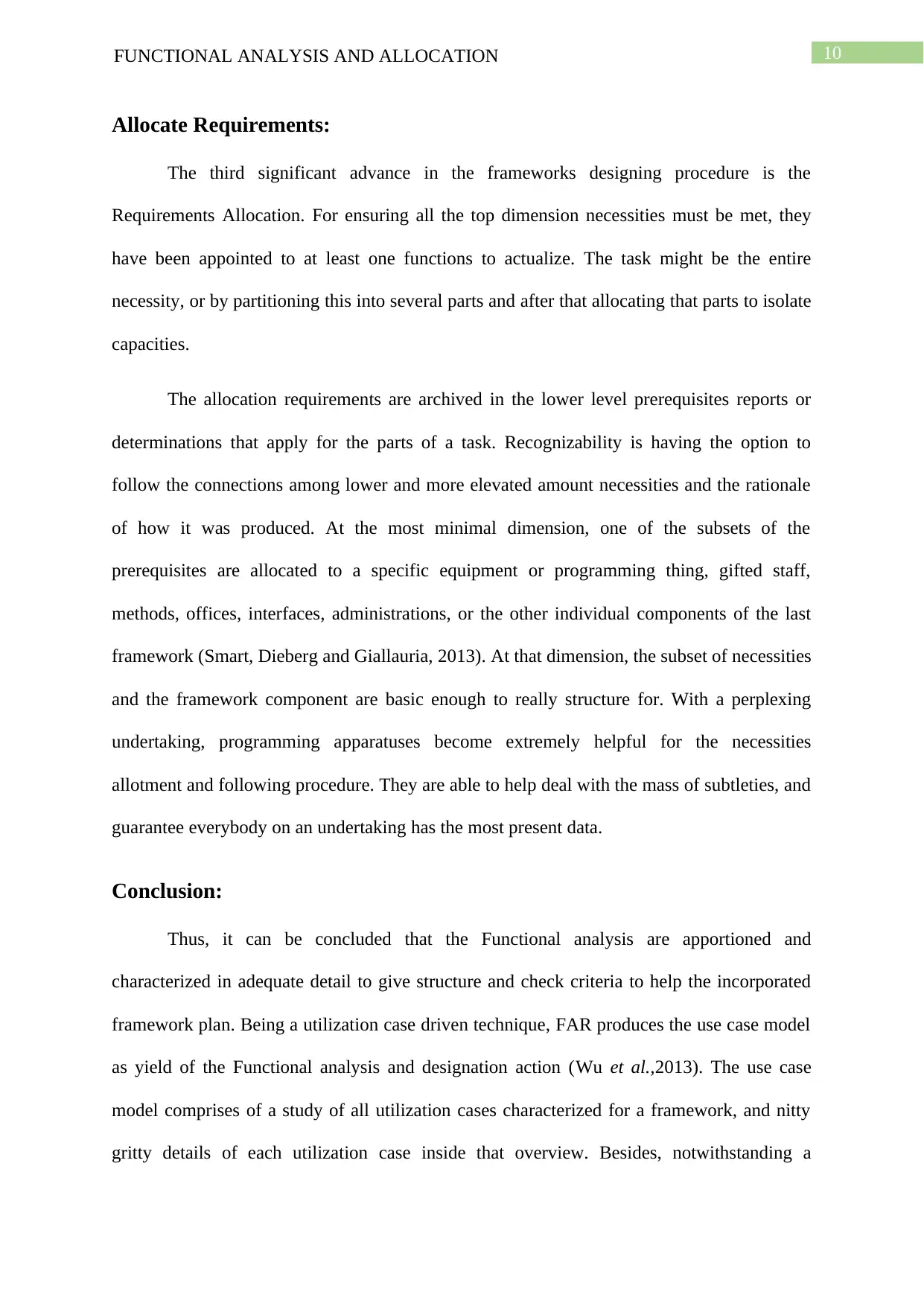
10FUNCTIONAL ANALYSIS AND ALLOCATION
Allocate Requirements:
The third significant advance in the frameworks designing procedure is the
Requirements Allocation. For ensuring all the top dimension necessities must be met, they
have been appointed to at least one functions to actualize. The task might be the entire
necessity, or by partitioning this into several parts and after that allocating that parts to isolate
capacities.
The allocation requirements are archived in the lower level prerequisites reports or
determinations that apply for the parts of a task. Recognizability is having the option to
follow the connections among lower and more elevated amount necessities and the rationale
of how it was produced. At the most minimal dimension, one of the subsets of the
prerequisites are allocated to a specific equipment or programming thing, gifted staff,
methods, offices, interfaces, administrations, or the other individual components of the last
framework (Smart, Dieberg and Giallauria, 2013). At that dimension, the subset of necessities
and the framework component are basic enough to really structure for. With a perplexing
undertaking, programming apparatuses become extremely helpful for the necessities
allotment and following procedure. They are able to help deal with the mass of subtleties, and
guarantee everybody on an undertaking has the most present data.
Conclusion:
Thus, it can be concluded that the Functional analysis are apportioned and
characterized in adequate detail to give structure and check criteria to help the incorporated
framework plan. Being a utilization case driven technique, FAR produces the use case model
as yield of the Functional analysis and designation action (Wu et al.,2013). The use case
model comprises of a study of all utilization cases characterized for a framework, and nitty
gritty details of each utilization case inside that overview. Besides, notwithstanding a
Allocate Requirements:
The third significant advance in the frameworks designing procedure is the
Requirements Allocation. For ensuring all the top dimension necessities must be met, they
have been appointed to at least one functions to actualize. The task might be the entire
necessity, or by partitioning this into several parts and after that allocating that parts to isolate
capacities.
The allocation requirements are archived in the lower level prerequisites reports or
determinations that apply for the parts of a task. Recognizability is having the option to
follow the connections among lower and more elevated amount necessities and the rationale
of how it was produced. At the most minimal dimension, one of the subsets of the
prerequisites are allocated to a specific equipment or programming thing, gifted staff,
methods, offices, interfaces, administrations, or the other individual components of the last
framework (Smart, Dieberg and Giallauria, 2013). At that dimension, the subset of necessities
and the framework component are basic enough to really structure for. With a perplexing
undertaking, programming apparatuses become extremely helpful for the necessities
allotment and following procedure. They are able to help deal with the mass of subtleties, and
guarantee everybody on an undertaking has the most present data.
Conclusion:
Thus, it can be concluded that the Functional analysis are apportioned and
characterized in adequate detail to give structure and check criteria to help the incorporated
framework plan. Being a utilization case driven technique, FAR produces the use case model
as yield of the Functional analysis and designation action (Wu et al.,2013). The use case
model comprises of a study of all utilization cases characterized for a framework, and nitty
gritty details of each utilization case inside that overview. Besides, notwithstanding a
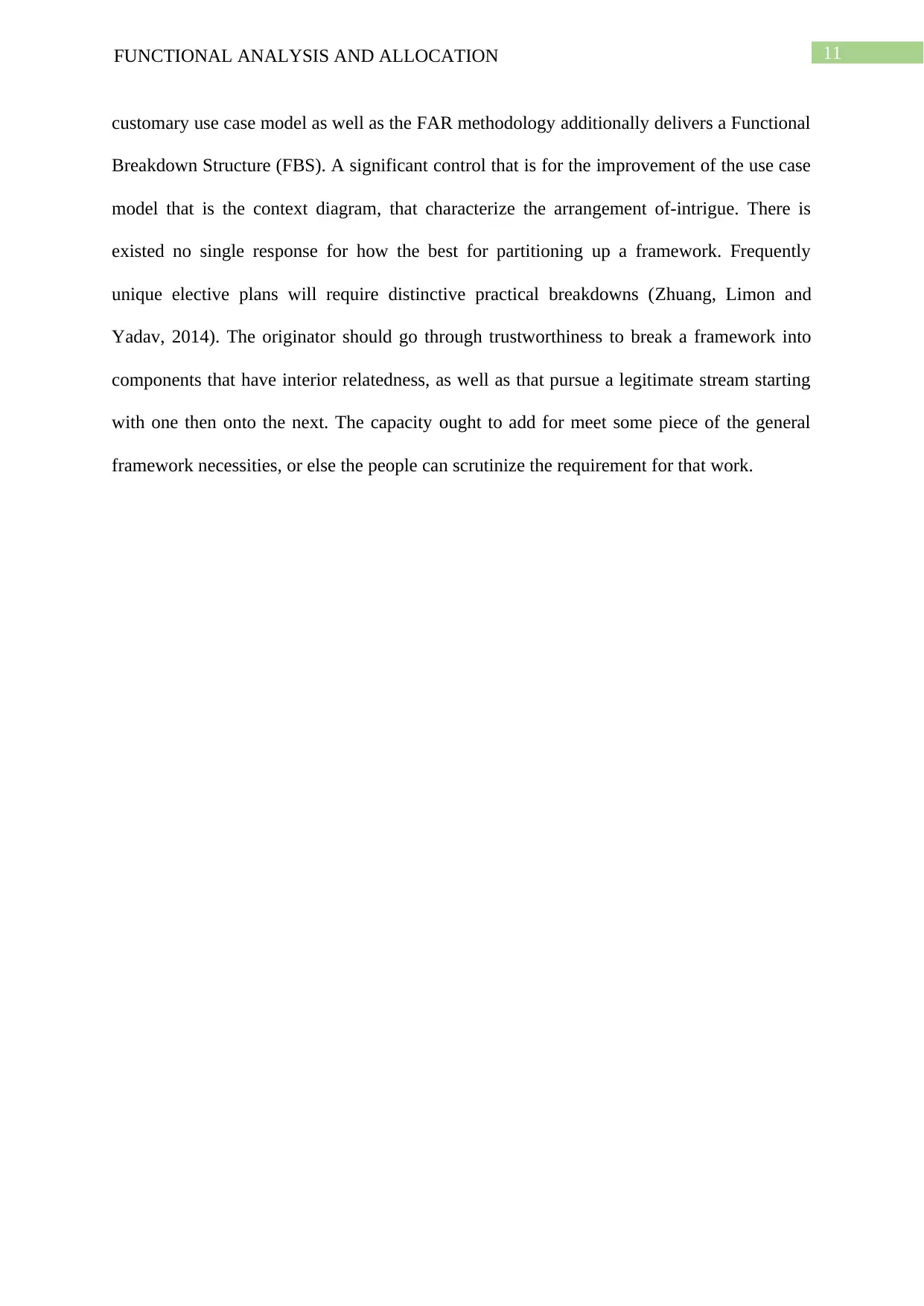
11FUNCTIONAL ANALYSIS AND ALLOCATION
customary use case model as well as the FAR methodology additionally delivers a Functional
Breakdown Structure (FBS). A significant control that is for the improvement of the use case
model that is the context diagram, that characterize the arrangement of-intrigue. There is
existed no single response for how the best for partitioning up a framework. Frequently
unique elective plans will require distinctive practical breakdowns (Zhuang, Limon and
Yadav, 2014). The originator should go through trustworthiness to break a framework into
components that have interior relatedness, as well as that pursue a legitimate stream starting
with one then onto the next. The capacity ought to add for meet some piece of the general
framework necessities, or else the people can scrutinize the requirement for that work.
customary use case model as well as the FAR methodology additionally delivers a Functional
Breakdown Structure (FBS). A significant control that is for the improvement of the use case
model that is the context diagram, that characterize the arrangement of-intrigue. There is
existed no single response for how the best for partitioning up a framework. Frequently
unique elective plans will require distinctive practical breakdowns (Zhuang, Limon and
Yadav, 2014). The originator should go through trustworthiness to break a framework into
components that have interior relatedness, as well as that pursue a legitimate stream starting
with one then onto the next. The capacity ought to add for meet some piece of the general
framework necessities, or else the people can scrutinize the requirement for that work.
⊘ This is a preview!⊘
Do you want full access?
Subscribe today to unlock all pages.

Trusted by 1+ million students worldwide
1 out of 15
Related Documents
Your All-in-One AI-Powered Toolkit for Academic Success.
+13062052269
info@desklib.com
Available 24*7 on WhatsApp / Email
![[object Object]](/_next/static/media/star-bottom.7253800d.svg)
Unlock your academic potential
Copyright © 2020–2025 A2Z Services. All Rights Reserved. Developed and managed by ZUCOL.





